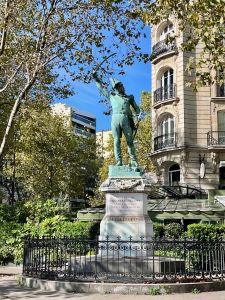
The imaginary dinner guest game is a no-frills conversation starter, a way to gain insight into favorite personalities. Choosing among living or dead, real or fictional characters, whom would you invite to a dinner party? Many would name Ernest Hemingway, provided they had plenty of good food and wine to go the distance.
Hemingway discussed imaginary dinner guests in an October 1944 letter to U.S Army Colonel Charles T. “Buck” Lanham, whom he had met that July while covering the war.1 Hemingway recounts a silly conversation about whom to invite to a fictional meal. He said he had thought about it and ruled out Jesus Christ, Napoleon, Lenin, Lincoln, French general Marcellus Marbot and French statesman Georges Clemenceau. Hemingway said he would be embarrassed by Christ; Napoleon would not be truthful; he did not know enough to talk to Lenin; Lincoln is okay but he does not like politicians; he has read all of Marbot; and he knew and liked Clemenceau.
Hemingway chose Michel Ney and Lanham as his dinner guests. From Ney they would learn about bravery and the human heart, as nobody knows himself or others until he has fought with a beaten army. Alluding to Ney’s rear guard actions covering Napoleon’s 1812 retreat from Moscow, Hemingway writes that actual and prolonged retreat is good training for many situations. As far as having Lanham at his table, Hemingway enjoyed chewing the fat with his pal.
In A Moveable Feast, Ney appears as an old friend to young Hemingway, his uniformed statue standing vigil in front of the Closerie des Lilas, Hemingway’s brasserie-office where he wrote during the 1920’s. Ney is Hemingway’s silent companion as his reveries turn to war, friendship, death, egotism and discipline.2
Maréchal Michel Ney was one of Napoleon’s top generals, a master tactician who from 1788-1815 led troops in battles across Europe in the French revolutionary wars and in Napoleon’s imperial wars. In the 1814 defeat of Paris, Ney helped engineer Napoleon’s abdication and shifted his allegiance to the king. After Napoleon’s 1815 escape from exile, Ney again sided with him and was one of Napoleon’s key commanders in the Waterloo defeat. For his betrayal of the royalists, Ney was executed by firing squad, refusing to wear a blindfold and issuing the order to fire. Hemingway was likely intrigued by Ney the hero-traitor and probably admired Ney’s fearless death.
In A Moveable Feast, Hemingway extols the transformative writing of his treasured Russian writers, including Tolstoy.3 Hemingway found Tolstoy’s depictions of the battlescape to be unmatched, and would have noticed in War and Peace that Napoleon departed the slaughter of the Moscow campaign in a warm fur coat, leaving Ney’s diminished troops at the back to defend France.4 Hemingway found Stendahl’s Waterloo chapter in Stendahl’s Le Chartreuse de Parme met the high bar set by Tolstoy.5 Stendahl’s hapless soldier Fabrizio spots Ney’s distinctive figure on the battlefield and beholds him in childish awe.6 Hemingway included Stendahl’s piece in his 1942 anthology Men at War along with the Waterloo chapter of Victor Hugo’s Les Misérables. Hugo paints a vivid portrait of Ney: “perspiring, his eyes aflame, foam on his lips” and “bleeding, bemired, magnificent, a broken sword in his hand.”7
Hemingway found Ney an inspiring presence for his Paris writing, his memoir leaving the visceral sense that Hemingway would have loved his hero statue Ney to come to life to talk to him.
1Hemingway, Ernest to Lanham, Charles T., October 17, 1944, Princeton University Library.
2__________, A Moveable Feast. New York: Scribner’s, 1964, p. 30.
3Ibid. 133
4Tolstoy, Leo. War and Peace. ClassicBooks, Kindle Edition, 2023, Chapters 17-18.
5Hemingway, Moveable Feast. 133-134
6Hemingway, Ernest, ed. Men at War: The Best War Stories of All Time. New York: Crown Publishers, 1942. 1025
7ibid. 695
Greer Rising and Eileen Martin are working on a book based on letters from Buck and Pete Lanham to Greer’s family that will explore the friendship between Lanham and Hemingway.